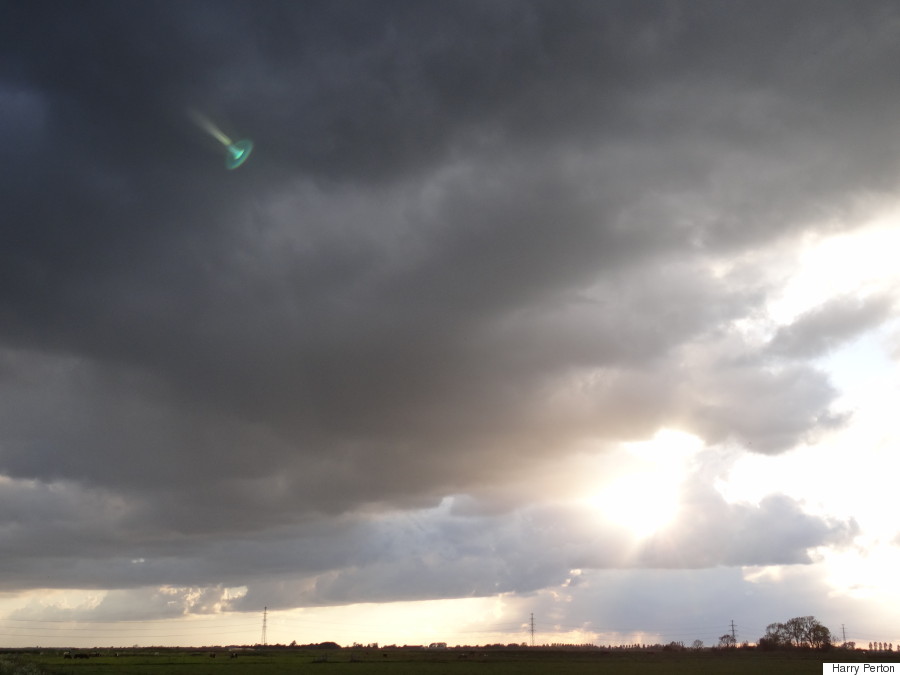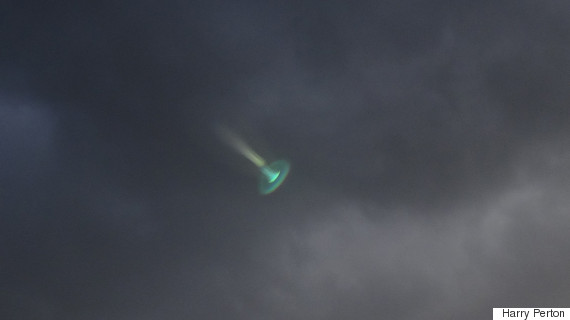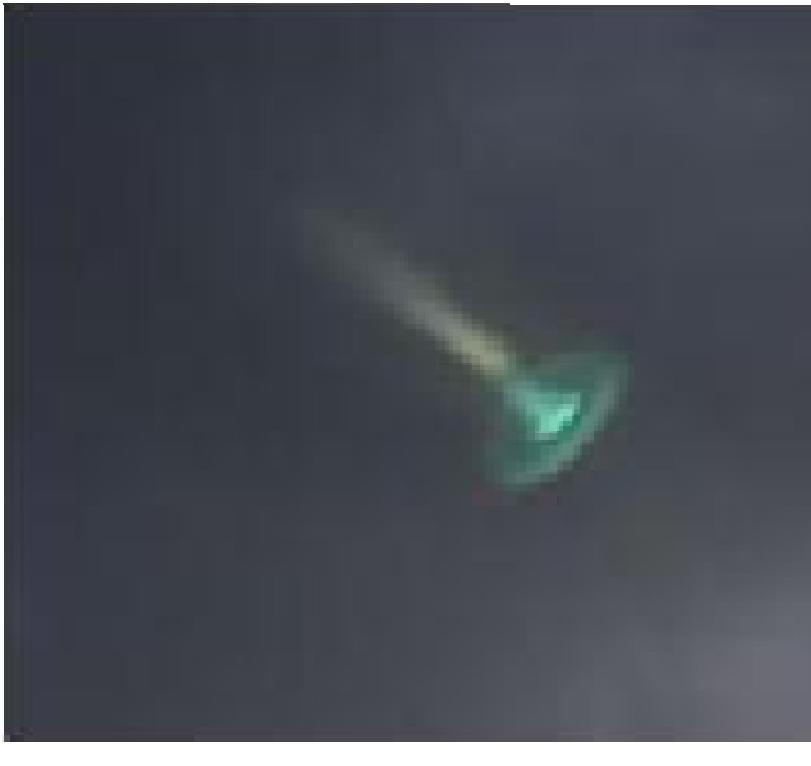It looks like you're using an Ad Blocker.
Please white-list or disable AboveTopSecret.com in your ad-blocking tool.
Thank you.
Some features of ATS will be disabled while you continue to use an ad-blocker.
share:
Striking picture of an extremely rare and as yet unknown atmospheric phenomenon, alien craft, hoax, strange sort of lens flare or something else
entirely?

From Huffington Post UK:
Here's the close up:

I'm leaning toward this being a real image of an unknown phenomenon and it appears that the photographer is as well. What about you ATS?

From Huffington Post UK:
Dutch photographer Harry Perton was out wandering around sundown taking pictures when he suddenly noticed a flash through his eyepiece.
At first thinking it might have been a bolt of lightning the photographer went back home and checked the files on his camera.
What he found truly shocked him. Unsure as to whether it was a UFO or something more meteorological the stunning image is actually not the first instance of a shape like this being seen.
Here's the close up:

I'm leaning toward this being a real image of an unknown phenomenon and it appears that the photographer is as well. What about you ATS?
a reply to: theantediluvian
It is cool looking. I like the green. Copper ionizing or oxidizing has a similar hue.

It is cool looking. I like the green. Copper ionizing or oxidizing has a similar hue.

edit on V582015Tuesdaypm30America/ChicagoTue, 02 Jun 2015 23:58:57 -05001 by Violater1 because: (no reason
given)
That is most-certainly a lens flair. Probably caused by a speck of moisture or dust on or in the lens.
You can tell because the "tail" is in a direction aligned with the setting sun.
You can tell because the "tail" is in a direction aligned with the setting sun.
Looks more funneled then a jellyfish. Like those Stargate things people were seeing a couple years ago.
Strange indeed.
Strange indeed.
It's green which is a pretty normal color for a meteor . And it appears to be breaking the sound barrier like the plane in this picture .

But that picture would've had to been snapped the second it met air resistance .

But that picture would've had to been snapped the second it met air resistance .
edit on 262015 by southernplayalistic because: no more beer... wait just one more
a reply to: SkepticOverlord
You can tell because the "tail" is in a direction aligned with the setting sun.
Yes, not only that but the setting sun is aligned with said "tail"...
Weak...
You can tell because the "tail" is in a direction aligned with the setting sun.
Yes, not only that but the setting sun is aligned with said "tail"...
Weak...
originally posted by: SkepticOverlord
That is most-certainly a lens flair. Probably caused by a speck of moisture or dust on or in the lens.
You can tell because the "tail" is in a direction aligned with the setting sun.
Yo Skep,
Your up late. Lens flare? Yep.
Do you feel like going to Dulce this weekend? Maybe we'll see something other than lens flares.
Location: Dulce Fishbone Array 36 59’53.58”N 106 51’35.72”W
edit on V362015Wednesdayam30America/ChicagoWed, 03 Jun 2015 00:36:32
-05001 by Violater1 because: (no reason given)
originally posted by: BestinShow
a reply to: SkepticOverlord
You can tell because the "tail" is in a direction aligned with the setting sun.
Yes, not only that but the setting sun is aligned with said "tail"...
Weak...
:
Also, the sun and "tail" are both aligned in the same direction.
originally posted by: SkepticOverlord
That is most-certainly a lens flair. Probably caused by a speck of moisture or dust on or in the lens.
You can tell because the "tail" is in a direction aligned with the setting sun.
'Most-certainly' is not 100% fact. For the dumb ones like me who had to look up some definitions like me.
Most-certainly = like....... 99% correct. Not enough.
a reply to: SkepticOverlord
I think you're probably correct. Certain features give it a less lens flare-y appearance than the run of the mill but the "tail" lining up with the sun is pretty telling. I've also found an image of a lens flare that looks fairly similar on Flickr:

I think you're probably correct. Certain features give it a less lens flare-y appearance than the run of the mill but the "tail" lining up with the sun is pretty telling. I've also found an image of a lens flare that looks fairly similar on Flickr:

originally posted by: theantediluvian
From Huffington Post UK:
When the sun is in your picture like that, I wouldn't exactly call it "chance lens flare", seeing as lens flare is very common when the sun or any other very bright light source is in your image.
simply a case of chance lens flare.
The sun and the flare are both equidistant from the center of the lens which is also typical of lens flare, and that kind of shape is common for lens flare, as seen in this lens flare image:
www.abovetopsecret.com...
Those lines were all added to show how the lens flare ends up opposite the light source, both equidistant from the center of the lens, where all those lines intersect. You can see the same symmetry in the OP image.
edit on 3-6-2015 by Arbitrageur because: clarification
a reply to: Arbitrageur
I had never really considered that light sources and lens flares are often equidistant from the center of the lens but it makes perfect sense. Thanks for taking the time to explain.
I had never really considered that light sources and lens flares are often equidistant from the center of the lens but it makes perfect sense. Thanks for taking the time to explain.
Please don't take this as a complaint or anything -
- it's really a 'me wondering if I'm losing my mind' kind of thing...
...wasn't there already a thread on this photo in the last week or so?
- it's really a 'me wondering if I'm losing my mind' kind of thing...
...wasn't there already a thread on this photo in the last week or so?
a reply to: theantediluvian
I caught a similar effect with my old Canon PowerShot, or whatever it was. It got stolen so no pics to post but I swear, it really DID happen!
I was photographing a dark mass of clouds early afternoon in late spring, years ago, ones that looked like they might bring rain or thunder, and in one image there was this green light torus with tail, against a relatively dark patch of cloud mass, similar to what you see here, except oriented vertically and less distinct.
In this photo, though the "plasma tail" of the lens flare is oriented towards the sun, which supports a lens flare theory. In my photo there was no bright sun breaking through at all -- UNLESS maybe it was, in the UV-spectrum, and that produced the lens flair oriented in the sun's direction. Kinda doubt it in both cases though.
Digital camera sensors are more or less UV-sensitive so artifacting of various bizarre kinds can occur when UV sources are present (as it did many times on my old iPhone4, especially photographing clouds. Wierd shapes showing up and stuff.)
Or maybe this is something real happening, in the UV spectrum, in the clouds -- perhaps strongly ionized air putting out UV-spectum strong enough for the camera to see, but not enough visible for the human eye to notice. Recall that (positively?) ionized air can give off a violet glow, most dramatically visible in some of old atmospheric a-bomb test footage. What sort of effect ionized air masses emitting UV light might produce in a digital photo would be hard to predict, it is certainly beyond me. But I seem to recall that when those UV artifacts do appear, they are in grayscale, not color as we see here.
I caught a similar effect with my old Canon PowerShot, or whatever it was. It got stolen so no pics to post but I swear, it really DID happen!
I was photographing a dark mass of clouds early afternoon in late spring, years ago, ones that looked like they might bring rain or thunder, and in one image there was this green light torus with tail, against a relatively dark patch of cloud mass, similar to what you see here, except oriented vertically and less distinct.
In this photo, though the "plasma tail" of the lens flare is oriented towards the sun, which supports a lens flare theory. In my photo there was no bright sun breaking through at all -- UNLESS maybe it was, in the UV-spectrum, and that produced the lens flair oriented in the sun's direction. Kinda doubt it in both cases though.
Digital camera sensors are more or less UV-sensitive so artifacting of various bizarre kinds can occur when UV sources are present (as it did many times on my old iPhone4, especially photographing clouds. Wierd shapes showing up and stuff.)
Or maybe this is something real happening, in the UV spectrum, in the clouds -- perhaps strongly ionized air putting out UV-spectum strong enough for the camera to see, but not enough visible for the human eye to notice. Recall that (positively?) ionized air can give off a violet glow, most dramatically visible in some of old atmospheric a-bomb test footage. What sort of effect ionized air masses emitting UV light might produce in a digital photo would be hard to predict, it is certainly beyond me. But I seem to recall that when those UV artifacts do appear, they are in grayscale, not color as we see here.
originally posted by: Greathouse
It's green which is a pretty normal color for a meteor . And it appears to be breaking the sound barrier like the plane in this picture .
But that picture would've had to been snapped the second it met air resistance .
I think that is a vapor vortex effect often touted as a plane breaking the sound barrier but not, you can find subsonic planes at low level with them. Can't look on my iPhone but might try later, not that it's important now identified as lense flare but I was initially under the idea that was sound barrier and was put straight! Goggle it perhaps :-)
a reply to: Greathouse
Only the angle IMO doesn't fit, as if it's going up and not down? And I also think it's some kind of light effect. .
Only the angle IMO doesn't fit, as if it's going up and not down? And I also think it's some kind of light effect. .
edit on 0b49America/ChicagoWed, 03 Jun 2015 05:21:49 -0500vAmerica/ChicagoWed, 03 Jun 2015 05:21:49 -05001 by 0bserver1 because: (no reason
given)
originally posted by: theantediluvian
Here's the close up:
"...in brightest day, in blackest night..."
You're welcome. Often but not always; you can get lens flare from the sun even if the sun isn't in the image (say if it's just outside the image, and you don't have a lens shade to prevent sunlight from striking the lens) in which case this equidistant phenomenon doesn't apply, but this is pretty common.
originally posted by: theantediluvian
a reply to: Arbitrageur
I had never really considered that light sources and lens flares are often equidistant from the center of the lens but it makes perfect sense. Thanks for taking the time to explain.
new topics
-
Rep. Alexandria O. Cortez Says Forcing People to Use The Correct Bathroom is Dangerous.
US Political Madness: 4 hours ago -
Cooperation zones
World War Three: 6 hours ago -
Ok this is some BS now WTH
Rant: 7 hours ago -
France gives Ukraine license to fire long-range missiles at Russia
World War Three: 9 hours ago
top topics
-
France gives Ukraine license to fire long-range missiles at Russia
World War Three: 9 hours ago, 9 flags -
Most INSANE internet rabbit hole
Secret Societies: 14 hours ago, 8 flags -
Joe Rogan conspiracy (maybe)
ATS Skunk Works: 17 hours ago, 5 flags -
Rep. Alexandria O. Cortez Says Forcing People to Use The Correct Bathroom is Dangerous.
US Political Madness: 4 hours ago, 4 flags -
Ok this is some BS now WTH
Rant: 7 hours ago, 3 flags -
Cooperation zones
World War Three: 6 hours ago, 3 flags -
Stalker 2 - Review from a Veteran
Video Games: 12 hours ago, 2 flags -
Does anyone have a link to download apple pay for androids
General Chit Chat: 13 hours ago, 1 flags
active topics
-
-@TH3WH17ERABB17- -Q- ---TIME TO SHOW THE WORLD--- -Part- --44--
Dissecting Disinformation • 3365 • : RelSciHistItSufi -
Ok this is some BS now WTH
Rant • 7 • : billxam1 -
Rep. Alexandria O. Cortez Says Forcing People to Use The Correct Bathroom is Dangerous.
US Political Madness • 16 • : Astrocometus -
France gives Ukraine license to fire long-range missiles at Russia
World War Three • 14 • : Astrocometus -
Cooperation zones
World War Three • 13 • : VariedcodeSole -
Mood Music Part VI
Music • 3714 • : Hellmutt -
Inca stone masonry at Sacsayhuaman, Ollantaytambo and the Sun Temple
Ancient & Lost Civilizations • 15 • : randomtangentsrme -
Dr Cambell talking about using worm meds for cancer
Medical Issues & Conspiracies • 24 • : ADVISOR -
President-Elect TRUMP Picks Former Florida A.G. PAM BONDI to be U.S. Attorney General.
2024 Elections • 65 • : VariedcodeSole -
Well, here we go red lines crossed Biden gives the go ahead to use long range missiles
World War Three • 332 • : Tolkien

